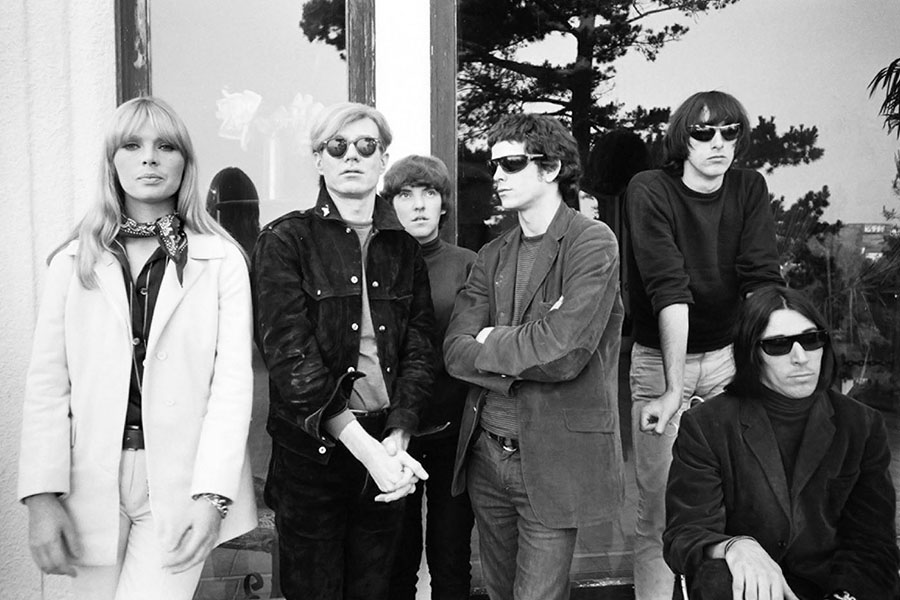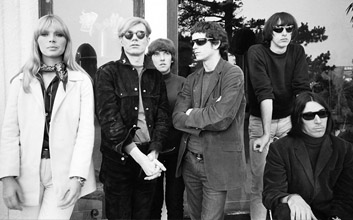This article appears in print in Happy Mag Issue 9. Grab your copy here.
“If it sells it must be alright.” A simple but innocent deception. But consumption is not value.
In the age of Big Data and streaming statistics have we forgotten that era-defining recordings aren’t always the million sellers? Artist’s legacies have never been about numbers. There’s a greater mythology at play, something more potent than figures. Music’s magnetism stretches further than the present.

From the Velvet Underground to J Dilla, we explore the meaning of commercial success in the context of creative greatness.
Increasingly, festivals, international touring and even our own personal tastes have come beholden to the logic of a hierarchy based on numbers. Living in an age where views, streams, likes, and shares are laid before our eyes at every turn, belief in this by-the-figures superiority is difficult to displace. Yet traditionally many of music’s most influential works sold poorly.
The Velvet Underground cast a long shadow, but in commercial terms, they were market failures. Their debut sold 30,000 copies in the first five years of its release. Brian Eno likewise. Post-Roxy Music he took Bowie low, travelled Talking Heads to Africa, all-but invented ambient music, and gave U2 some of their greatest hits. Yet his first four solo works – the seminal Another Green World and Discreet Music notwithstanding– were non-sellers.
The Stooges’ Raw Power and Fun House were commercial disasters. The Ramones’ Ramones sold 6,000 copies in its first year, only hitting hit Gold in the US 38 years after its release in 2014. No joke.
Other notable mentions include hip-hop lodestone Enter the Wu-Tang (36 Chambers), the now platinum The Violent Femmes, The Replacements’ Let It Be, the Pixies’ Surfa Rosa as well as just about every signature riot grrrl act and hardcore punk release. Throw in The Raincoats, Robert Johnston, Lydia Lunch, Wire, and The Fall for good measure.
These artists struggled to “move product”. They often flopped, their failures unmourned. Even the more successful seldom did more than straddle the charts. Shunned, ignored and derided, their works were not statements of music’s present but it’s future. They didn’t sell but they stuck.
Over time they’ve been elevated, adored and worshipped, touchstones for subsequent generations. The values which made them pariahs – their utter disregard for prevailing taste, their scepticism, their idiosyncrasies and cynical twists – came to align with that which had yet to come.
Even incumbents and heavy hitters are not immune to such slow-burning appeal. Take Pet Sounds. In 1966, The Beach Boys’ 11th flopped in the US, their lowest charting album. Despite two hit singles, it’s orchestral pop was less than conducive to popular taste. While later celebrated, it marked the end of a marathon career high.
The Kinks’ The Kinks Are the Village Green Preservation Society stands upon similar ground. It failed to chart period. Despite selling less than 100,000 copies in its initial run, it became the group’s best selling studio LP.
Many would proffer these albums and many more besides are statements that changed the course of history, or at the very least, popular taste. Even those who would contest such claims could do little to deny these albums have commanded loyalty and fostered inspiration well past the immediacy of their arrival.
You could also think in terms of broader musical movements. ‘70s punk wasn’t the music of the people. It was, by nature, the domain of elitist outsiders. Most people hated it. Yet it’s attitude continues to send ripples through popular thought.
What’s more, mass appeal and reclusive genius aren’t as comfortably opposed as many would think. Music’s commercial heavyweights not only bring art to the masses and sometimes great artists with them. Bob Dylan might have received the Nobel Prize in Literature, but his career wouldn’t have had much of a start if Peter, Paul & Mary, Joan Baez, Stevie Wonder and The Byrds hadn’t delivered sanitised covers of his work. Likewise, Leonard Cohen and Joni Mitchell got their breaks from Judy Collins.
It’s hard to spur a mass reaction with something which carries complex statements and artistic flair. These interpreters smooth over innovators’ rough edges. And there was no golden era where brilliant minds strolled into the mainstream unopposed.
Re-enter our nefarious train of thought. “If it’s popular it must be good!” Credibility by default consumption. The cold hard truth.
But there’s an assumption here. It’s that all sales or streams of albums and songs – units of music consumption – are somehow weighted equal. By this reasoning, a stream, purchase, or whatever metric of use you wish to employ, holds the same empowering value. But straight-up figures don’t always don’t tell the entire story. They don’t reveal the reasons why goods were chosen by a consumer in the first place or even whether they enjoyed the experience. Value is not consumption.
Different individuals make different judgements about musical value. As fans, we never cease evaluating the good, bad, irrelevant and worthwhile. Yet two opinions are rarely alike. There is no ‘typical fan’.
Most value music for its expression of non-musical concerns and on the basis of its appropriateness to their social settings. Music is an object of identification and fantasy. Yet a more musical mind might be more inclined to praise an artist’s work based on skill, technique, or technological expertise.
What seems popular might not even be what’s really popular. There’s a tendency to ignore the significant unpopularity of high sellers. Consider the regard ‘90s survivors hold for Vanilla Ice in relation to contemporaries like J Dilla, PJ Harvey or The Stone Roses. Look closer to home. The likes of the Saints and Nick Cave and The Bad Seeds seem more deeply ingrained in Australian minds than the Little River Band. Why?
Consider the idea of ‘middle brow’: the domain of the easy listener and the light reader – minds possessed of passivity. How do you weigh the numbers of these against those of bleeding heart obsessives? To one fan, an album or song might change their life, grant them purpose, fill their thoughts or anchor their identity. They feel it all the way to their core. To another, it’s just background noise or fodder for party playlists.
In a notorious interview recently conducted with Vulture, The Strokes’ Julian Casablancas romanticised an ideal and hypothetical world where Ariel Pink would be more popular than Ed Sheeran. But if you take eyes off numbers and industry adulation even for even a second something becomes clear. Does that world already exist?
An artists’ impact extends past their moment. Some smoulder slowly, others flash. True greats endure. Others ignite well after arrival.
Sure, the easily digestible and safe command numbers. People respond more positively to what they know and what their expectation dictates they’re ready to receive. Nostalgia and familiarity sell, they always have. But as Weezer’s tepid cover of Toto’s ‘Africa’ attests, it also presents the risk of becoming hamstrung by aesthetic safety.
Don’t believe the sales pitch. Culture isn’t always improving. Popular music goes through long periods of stagnation just as equally as it encounters flares of innovation. Technology has always been a driving force but there have been other factors too. Not the least of these is the work of outsiders.
This isn’t an “if it’s popular it must be bad unless it’s popular with the right people” kind of thing. By no means is this extolling the virtues of the notion that the fewer people who like the music the better it is. Straight up put that rich vein of nonsense out of your head.
But consider the artists of underground worlds. Spaces too eccentric or subversive for public access. They disrupt the order of things producing the artfully obtuse and questioning our concept of truth. Trapped in their own cosmos, they sit convinced of their own view, right and righteous to the exception of all else – innovators at the sidelines of popular culture, defying genre and bending popular forms into new shapes. They test limits and push boundaries, not chasing listener’s desires but challenging them to catch up to their own.
These acts who stay in their own lane with just enough fans and support to sustain them, it’s where they’ve always been and from where they work. Those operating on these terms shouldn’t be discounted.
None of this is to say innovation, seriousness, rebellion or excellence sit on any one side of commercial-underground divides. The popular and creative aren’t mutually exclusive. When they aren’t overlapping they sit within a rich and interconnected ecosystem. They feed off of one another.
Music’s hierarchies logically challenge one another and in doing so refresh themselves. Oppressive conformity breeds inspired losers while accessible artist take art to the masses the recluses can’t. Creativity is omnivorous.
To celebrate statistics alone is to deny music’s future. Much of the way forward has always belonged in the hands of outsiders, misfits and outcasts. Those who seek to participate in the conversation but only upon their own terms. They share little ground with their contemporaries but through self-deception or self-belief propel themselves to greater myth.
Commercial success is often held as a mark of quality, and sure, that which is universal and instantaneous does capture contemporary excitement like nothing else. Yet all too often this music invokes thoughts and feelings which leave no sooner than they arrive. In this wake, not a single powerful idea or image remains. So spare a thought for those striving for a little more. Now more than ever we’re unlikely to be finding them labouring in plain sight.
This article appears in print in Happy Mag Issue 9. Grab your copy here.



